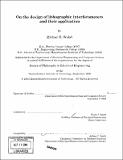On the design of lithographic interferometers and their application
Author(s)
Walsh, Michael E. (Michael Edward), 1975-
DownloadFull printable version (50.91Mb)
Other Contributors
Massachusetts Institute of Technology. Dept. of Electrical Engineering and Computer Science.
Advisor
Henry I. Smith.
Terms of use
Metadata
Show full item recordAbstract
Interference lithography is presented as an ideal technique for fabricating large-area periodic structures with sub-100nm dimensions. A variety of interferometer designs are discussed and implemented, each of which emphasizes a different attribute. Curvature of the substrate during exposures in a Mach-Zender interferometer is demonstrated as a method for reducing periodicity variations in the printed pattern down to the level of picometers. A robust Lloyd's-mirror interferometer is developed as a simple and flexible lithography system capable of sub-100nm features. Prospects and designs for the use of grating interferometers for the fabrication of structures with 50nm spatial-periodicity are discussed. A novel, integrated, thin-film interferometer exploiting solid immersion is introduced for the fabrication of features below the diffraction-limit. Using 193nm illumination, 45nm dense features are demonstrated. Aspects of sub-wavelength diffraction and thin-film resonance are discussed in relation to the fabrication of structures with sub-50nm periodicity. A selection of applications are discussed which take advantage of the unique capabilities of interference lithography, including patterned magnetic media, DFB lasers and the templated self-assembly of nano-particles. A novel technique for ion-beam etching, applicable to any material system, is shown to improve the patterning of nanoscale magnetic elements.
Description
Thesis (Ph. D.)--Massachusetts Institute of Technology, Dept. of Electrical Engineering and Computer Science, 2004. Page 300 blank. Includes bibliographical references.
Date issued
2004Department
Massachusetts Institute of Technology. Department of Electrical Engineering and Computer SciencePublisher
Massachusetts Institute of Technology
Keywords
Electrical Engineering and Computer Science.